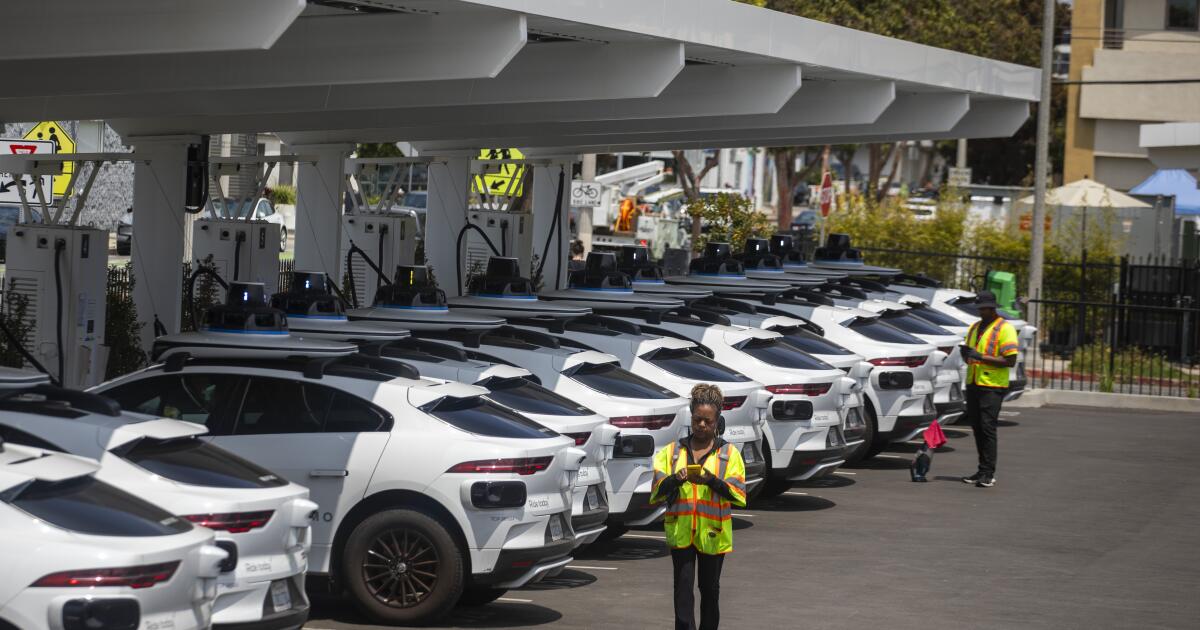Business
Will teens save the movies? Here's what a surprising new study says about youth and Hollywood

Good news for theaters still recovering from the COVID-19 pandemic and other industry disruptions: A new UCLA study has found that teenagers’ favorite thing to do is going to the movies.
The latest installment of the university’s “Teens and Screens” report — which surveyed 1,500 young people across the U.S. ages 10 to 24 — identified going to see a film on opening weekend as adolescents’ No. 1 preferred pastime when cost, transportation and other barriers are removed from the equation.
Among that age group, moviegoing ranked above watching sports, playing video games, streaming movies or TV shows on personal devices and other forms of entertainment.
When factoring in cost and other obstacles, however, 39.2% of teens selected playing video games as their favorite activity over watching TV or movies (33.3%) or scrolling on social media (27.5%).
“The lore really is that all they care about is social media and YouTube and streaming and bingeing and that the movie business is dead,” said Yalda Uhls, executive director of the Center for Scholars and Storytellers at UCLA.
“I was buying into the narrative that kids don’t care about movies as much. But the reality is, when you ask them, they really do care.”
Movie theaters need all the youthful enthusiasm they can get. Box office ticket sales in the U.S. and Canada are down 11% from last year and remain significantly lower than pre-pandemic levels, according to Comscore.
Uhls, a former movie executive, said that studios tend to ignore the teen demographic and that in order to effectively tap into that market, they need to do a better job of reaching out to young people of various backgrounds and taking their habits and preferences into account.
“Do the research,” Uhls said. “If you’re making content for teens, think about the lived experience of all teens.”
So what do teenagers want to see onscreen?
According to the UCLA report, 36.2% of adolescents prefer fantasy over other genres; 63.5% value stories about friendship and platonic relationships over romance; and 62.4% believe that sex scenes are not necessary to advance the plot of TV shows and movies. (Only survey participants 14 and older were asked for their opinions about on-screen sex.)
Each of those totals saw a huge jump (of at least 39%) compared with last year’s study.
On the other end of the spectrum, only 7.2% of young people enjoyed movies and TV shows about the rich and famous; 13.9% said they wanted to watch films and series tackling real-life issues that affect society.
Amid all of the information about shootings, climate change, injustice, politics, war and other real-world issues dominating the news and social media, kids need an escape, Uhls said. And not just in the form of superhero movies.
“It feels like that’s all we give them,” Uhls said. “They want to see a broader array.”
On the exhibition side, theaters can attract more teens by offering event screenings — encouraging patrons to wear costumes to the show, for example — and offering group discounts for young people, Uhls said.
“It’s just that typical moviegoing experience,” Uhls added. “They all love it the way I did growing up … and if you give it to them, they will come.”

Business
Snoopy is everywhere right now — from jewelry to pimple patches. Why?

As a child, Clara Spars, who grew up in Charles M. Schulz’s adoptive hometown of Santa Rosa, assumed that every city had life-size “Peanuts” statues dotting its streets.
After all, Spars saw the sculptures everywhere she went — in the Santa Rosa Plaza, at Montgomery Village, outside downtown’s Empire Cleaners. When she and her family inevitably left town and didn’t stumble upon Charlie Brown and his motley crew, she was perplexed.
Whatever void she felt then is long gone, since the beagle has become a pop culture darling, adorning all manner of merchandise — from pimple patches to luxury handbags. Spars herself is the proud owner of a Baggu x Peanuts earbuds case and is regularly gifted Snoopy apparel and accessories.
“It’s so funny to see him everywhere because I’m like, ‘Oh, finally!’” Spars said.
The spike in Snoopy products has been especially pronounced this year with the 75th anniversary of “Peanuts,” a.k.a. Snoopy’s 75th birthday. But the grip Snoopy currently has on pop culture and the retail industry runs deeper than anniversary buzz. According to Sony, which last week acquired majority ownership of the “Peanuts” franchise, the IP is worth half a billion dollars.
To be clear, Snoopy has always been popular. Despite his owner being the “Peanuts” strip’s main character and the namesake for most of the franchise’s adaptations, Snoopy was inarguably its breakout star. He was the winner of a 2001 New York Times poll about readers’ favorite “Peanuts” characters, with 35% of the vote.
This year, the Charles M. Schulz Museum celebrated the 75th anniversary of the “Peanuts” comic strip’s debut.
(Brennan Spark / Charles M. Schulz Museum)
But the veritable Snoopymania possessing today’s consumers really exploded with the social media boom of the early 2010s, said Melissa Menta, senior vice president of global brand and communications for Peanuts Worldwide.
That’s also when the company saw the first signs of uncharacteristically high brand engagement, Menta said. She largely attributed the success of “Peanuts” on social media to the comic strip’s suitability to visual platforms like Instagram.
“No one reads the comic strips in newspapers anymore,” Menta said, “but if you think about it, a four-panel comic strip, it’s actually an Instagram carousel.”
Then, in 2023, Peanuts Worldwide launched the campaign that made Snoopy truly viral.
That year, the brand partnered with the American Red Cross to create a graphic tee as a gift for blood donors. The shirt, which featured Snoopy’s alter ego Joe Cool and the message “Be Cool. Give Blood,” unexpectedly became internet-famous. In the first week of the collaboration, the Red Cross saw a 40% increase in donation appointments, with 75% of donors under the age of 34.
“People went crazy over it,” Menta said, and journalists started asking her, “Why?”
Her answer? “Snoopy is cute and cool. He’s everything you want to be.”

“Charles Schulz said the only goal he had in all that he created was to make people laugh, and I think he’s still doing that 75 years later,” Schulz Museum director Gina Huntsinger said.
(Brennan Spark / Charles M. Schulz Museum)
The Red Cross collaboration was so popular that Peanuts Worldwide brought it back this year, releasing four new shirt designs. Again, the Snoopy fandom — plus some Woodstock enthusiasts — responded, with 250,000 blood donation appointments made nationwide in the month after the collection’s launch.
In addition to the Red Cross partnership, Peanuts Worldwide this year has rolled out collaborations with all kinds of retailers, from luxury brands like Coach and Kith to mass-market powerhouses like Krispy Kreme and Starbucks. Menta said licensed product volume is greater than ever, estimating that the brand currently has more than 1,200 licensees in “almost every territory around the world,” which is approximately four times the number it had 40 years ago.
Then again, at that time, Schulz enjoyed and regularly executed veto power when it came to product proposals, and licensing rules were laid out in what former Times staff writer Carla Lazzareschi called the “Bible.”
“The five-pound, 12-inch-by-18-inch binder given every new licensee establishes accepted poses for each character and painstakingly details their personalities,” Lazzareschi wrote in a 1987 Times story. “Snoopy, for example, is said to be an ‘extrovert beagle with a Walter Mitty complex.’ The guidelines cover even such matters as Snoopy’s grip on a tennis racquet.”
Although licensing has expanded greatly since then, Menta said she and her retail development associates “try hard not to just slap a character onto a T-shirt.” Their goal is to honor Schulz’s storytelling, she added, and with 18,000 “Peanuts” strips in the archive, licensees have plenty of material to pull from.
Rick Vargas, the senior vice president of merchandising and marketing at specialty retailer BoxLunch, said his team regularly returns to the Schulz archives to mine material that could resonate with customers.
“As long as you have a fresh look at what that IP has to offer, there’s always something to find. There’s always a new product to build,” Vargas said.
Indeed, this has been one of BoxLunch’s strongest years in terms of sales of “Peanuts” products, and Snoopy merchandise specifically, the executive said.

BaubleBar co-founder Daniella Yacobovsky said the brand’s “Peanuts” collaboration was one of its most beloved yet.
(BaubleBar)
Daniella Yacobovsky, co-founder of the celebrity-favorite accessory retailer BaubleBar, reported similar high sales for the brand’s recent “Peanuts” collection.
“Especially for people who are consistent BaubleBar fans, every time we introduce new character IP, there is this huge excitement from that fandom that we are bringing their favorite characters to life,” Yacobovsky said.
The bestselling item in the collection, the Peanuts Friends Forever Charm Bracelet, sold out in one day. Plus, customers have reached out with new ideas for products linked to specific “Peanuts” storylines.
More recently, Peanuts Worldwide has focused on marketing to younger costumers in response to unprecedented brand engagement from Gen Z. In November, it launched a collaboration with Starface, whose cult-favorite pimple patches are a staple for teens and young adults. The Snoopy stickers have already sold out on Ulta.com, Starface founder Julie Schott said in an emailed statement, adding that the brand is fielding requests for restocks.
“We know it’s a certified hit when resale on Depop and EBay starts to spike,” Schott said.
The same thing happened in 2023, when a CVS plush of Snoopy in a puffer jacket (possibly the dog’s most internet-famous iteration to date) sold out in-store and started cropping up on EBay — for more than triple the original price.
The culprits were Gen-Zers fawning over how cute cozy Snoopy was, often on social media.

“People who love Snoopy adore Snoopy, whether you grew up with ‘Peanuts’ or connect with Snoopy as a meme and cultural icon today,” said Starface founder Julie Schott.
(Starface World Inc.)
Hannah Guy Casey, senior director of brand and marketing at Peanuts Worldwide, said in 2024, the official Snoopy TikTok account gained 1.1 million followers, and attracted 85.4 million video views and 17.6 million engagements. This year, the account has gained another 1.2 million followers, and racked up 106.5 million video views and 23.2 million engagements.
Guy Casey noted that TikTok is where the brand experiences much of its engagement among Gen Z fans.
Indeed, the platform is a hot spot for fan-created Snoopy content, from memes featuring the puffer jacket to compilations of his most relatable moments. Several Snoopy fan accounts, including one dedicated to a music-loving Snoopy plushie, boast well over half a million followers.
Caryn Iwakiri, a speech and language pathologist at Sunnyvale’s Lakewood Tech EQ Elementary School whose classroom is Snoopy-themed, recently took an impromptu trip to the Charles M. Schulz Museum in Santa Rosa after seeing its welcome center decked out with Snoopy decor on TikTok. Once she arrived, she realized the museum was celebrating the “Peanuts” 75th anniversary.

Last year, the Schulz Museum saw its highest-ever attendance, driven in large part by its increased visibility on social media.
(Brennan Spark / Charles M. Schulz Museum)
It’s a familiar story for Schulz Museum director Gina Huntsinger.
“Last December, we were packed, and I was at the front talking to people, and I just randomly asked this group, ‘Why are you here?’”
It turned out that the friends had traveled from Washington, D.C., and Las Vegas to meet in Santa Rosa and visit the museum after seeing it on TikTok.
According to Stephanie King, marketing director at the Schulz Museum, the establishment is experiencing its highest-ever admissions since opening in 2002. In the 2024–2025 season, the museum increased its attendance by nearly 45% from the previous year.
Huntsinger said she’s enjoyed watching young visitors experience the museum in new ways.
In the museum’s education room, where visitors typically trace characters from the original Schulz comics or fill out “Peanuts” coloring pages, Gen Z museumgoers are sketching pop culture renditions of Snoopy — Snoopy as rock band Pierce the Veil, Snoopy as pop star Charli XCX.
“When our social media team puts them up [online], there’s these comments among this generation that gets this, and they’re having conversations about it,” Huntsinger said. “It’s dynamic, it’s fun, it’s creative. It makes me feel like there’s hope in the world.”

The Schulz Museum’s “Passport to Peanuts” exhibition emphasizes the comic’s global reach.
(Brennan Spark / Charles M. Schulz Museum)
Laurel Roxas felt similarly when they first discovered “Peanuts” as a kid while playing the “Snoopy vs. the Red Baron” video game on their PlayStation Portable. For Roxas, who is Filipino, it was Snoopy and not the “Peanuts” children who resonated most.
“Nobody was Asian. I was like, ‘Oh, I’m not even in the story,’” they said.
Because Snoopy was so simply drawn, Roxas added, he was easy to project onto. They felt similarly about Hello Kitty; with little identifying features or dialogue of their own, the characters were blank canvases for their own personification.
Roxas visited Snoopy Museum Tokyo with their brother last year. They purchased so much Snoopy merchandise — “everything I could get my hands on” — that they had to buy additional luggage to bring it home.
For some Snoopy enthusiasts, the high volume of Snoopy products borders on oversaturation, threatening to cheapen the spirit of the character.
Growing up, Bella Shingledecker loved the holiday season because it meant that the “Peanuts” animated specials would be back on the air. It was that sense of impermanence, she believes, that made the films special.
Now, when she sees stacks of Snoopy cookie jars or other trend-driven products at big-box stores like T.J. Maxx, it strikes her as a bit sad.
“It just feels very unwanted,” she said. For those who buy such objects, she said she can’t help but wonder, “Will this pass your aesthetic test next year?”
Lina Jeong, for one, isn’t worried that Snoopy’s star will fade.

“[Snoopy is] always able to show what he feels, but it’s never through words, and I think there’s something really poetic in that,” said Lina Jeong.
(Brennan Spark / Charles M. Schulz Museum)
Jeong’s affinity for the whimsical beagle was passed down to her from her parents, who furnished their home with commemorative “Peanuts” coffee table books. But she fell in love with Snoopy the first time she saw “Be My Valentine, Charlie Brown,” which she rewatches every Valentine’s Day.
This past year, she was fresh out of a relationship when the holiday rolled around and she found herself tearing up during scenes of Snoopy making Valentine’s crafts for his friends.
“Maybe I was hyper-emotional from everything that had happened, but I remember being so struck,” that the special celebrated platonic love over romantic love, Jeong said.
It was a great comfort to her at the time, she said, and she knows many others have felt that same solace from “Peanuts” media — especially from its dear dog.
“Snoopy is such a cultural pillar that I feel like fads can’t just wash it off,” she said.
Soon, she added, she plans to move those “Peanuts” coffee table books into her own apartment in L.A.
Business
Fight between Waymo and Santa Monica goes to court

Waymo is taking the city of Santa Monica to court after the city ordered the company to cease charging its autonomous vehicles at two facilities overnight, claiming the lights and beeping at the lots were a nuisance to residents.
The two charging stations at the intersection of Euclid Street and Broadway have been a sour point for neighbors since they began operating roughly a year ago. Some residents have told The Times they’ve been unable to sleep because of the incessant beeping from Waymos maneuvering in and out of charging spots on the lot 24 hours a day.
Last month, the city ordered Waymo and the company that operates the charging stations, Voltera, to stop overnight operations at the sites, arguing that the light, noise and activity there constitute a public nuisance. Instead of complying, Waymo has turned around and filed a suit against the city, asking the court to intervene.
“Waymo’s activities at the Broadway Facilities do not constitute a public nuisance,” the company argued in its complaint, filed Wednesday in Los Angeles County Superior Court. “Waymo faces imminent and irreparable harm to its operations, employees, and customers.”
A spokesperson for the city did not immediately respond to a request for comment.
According to the suit, the city was aware that the Voltera charging facilities were to operate and maintain a commercial electric vehicle fleet 24 hours a day, and the city approved its use when it approved the permits for the stations.
The rift between the company and some Santa Monica residents began as soon as the vehicles began utilizing the 24-hour charging stations, which have overnight staffing, lights and cars beeping as they reverse in and out of parking spots. Tensions got so bad that some residents took to blocking the path of the driverless vehicles, blocking the driveways into the charging stations, and placing orange cones in the area to hinder their routes and create backups, a practice several have called “stacking the Waymos.”
Meanwhile, employees at the charging stations have called police several times as a result, although no arrests have been made. Waymo also unsuccessfully attempted to obtain a temporary restraining order against one resident who had allegedly repeatedly blocked the vehicles.
On Nov. 19, the city ordered Waymo to stop charging its autonomous cars at the two lots overnight or face the possibility of legal action. Waymo declined and instead sued the city last week after negotiations with the city on mitigation measures to the lots fell apart.
According to the lawsuit, Waymo and Voltera representatives reached out to the city after the Nov. 19 order, looking for ways to mitigate the noise and lights from the lots, including initiating a software update that would change the vehicles’ path to the charging stations. But after a meeting on Dec. 15 with the city, no agreement was reached, the company said in its complaint.
“We are disappointed that the City has chosen an adversarial path over a collaborative one,” a spokesperson for Waymo said in a statement.
“The City’s position has been to insist that no actions taken or proposed by Waymo would satisfy the complaining neighbors and therefore must be deemed insufficient.”
The company also blasted the city’s handling of the dispute, arguing that despite facing a budget crisis, city officials have adopted a contentious strategy against business.
“The City of Santa Monica’s recent actions are inconsistent with its stated goal of attracting investment,” the company said in a statement. “At a time when the City faces a serious fiscal crisis, officials are choosing to obstruct properly permitted investment rather than fostering a ‘ready for business’ environment.”
The lawsuit is just the latest legal battle for the Alphabet-owned company, which has been rapidly expanding across California, making the white, driverless vehicles more commonplace.
Two years ago, the company was sued by the city of San Francisco, which argued that the California Public Utilities Commission shouldn’t have handed Waymo permits to expand and operate in the city, and that the regulatory agency had abdicated its responsibilities.
The California 1st District Court of Appeal disagreed, and ruled against the city.
This past June, Waymo announced it would expand its service area to 120 square miles in Los Angeles County, with Waymos operating in Playa del Rey, Ladera Heights, Echo Park, Silver Lake and Hollywood.
In November the company launched its ride-hailing service to now operate across Los Angeles County freeways, as well as in the San Francisco Bay and Phoenix.
Since it launched in Santa Monica, the company argues it has done more than a million trips in the city and in November alone, recorded more than 50,000 rides starting or ending there.
“The [charging] site has enabled Waymo to provide a safe, sustainable and accessible transportation option to city residents,” Waymo said in the statement.
Business
Video: Uber Clears Violent Felons to Drive

new video loaded: Uber Clears Violent Felons to Drive
By Emily Steel, Christina Shaman, Zach Caldwell, David Jouppi and Thomas Trudeau
December 22, 2025
-

 Iowa1 week ago
Iowa1 week agoAddy Brown motivated to step up in Audi Crooks’ absence vs. UNI
-

 Maine1 week ago
Maine1 week agoElementary-aged student killed in school bus crash in southern Maine
-

 Maryland1 week ago
Maryland1 week agoFrigid temperatures to start the week in Maryland
-

 New Mexico7 days ago
New Mexico7 days agoFamily clarifies why they believe missing New Mexico man is dead
-

 South Dakota1 week ago
South Dakota1 week agoNature: Snow in South Dakota
-

 Detroit, MI1 week ago
Detroit, MI1 week ago‘Love being a pedo’: Metro Detroit doctor, attorney, therapist accused in web of child porn chats
-

 Health1 week ago
Health1 week ago‘Aggressive’ new flu variant sweeps globe as doctors warn of severe symptoms
-

 Maine7 days ago
Maine7 days agoFamily in Maine host food pantry for deer | Hand Off
















